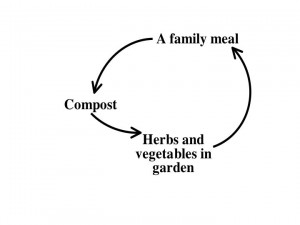Waste = Food (or Why I Love Johnny Appleseed)
I’m becoming more and more convinced that when it comes to living “green” – or within the means of nature – we don’t have to get an advanced degree, or follow a 20-point check list. Much of what we need to do is remember what we already know.
 I grew up reading about Johnny Appleseed (real name: John Chapman), the American folk hero who walked across America planting apple trees, handing out small bags of apple seeds along the way. Last night, I read “The Story of Johnny Appleseed” (Aliki’s version) with my seven-year old son. It was the perfect ending to Halloween madness. We both paused at this line:
I grew up reading about Johnny Appleseed (real name: John Chapman), the American folk hero who walked across America planting apple trees, handing out small bags of apple seeds along the way. Last night, I read “The Story of Johnny Appleseed” (Aliki’s version) with my seven-year old son. It was the perfect ending to Halloween madness. We both paused at this line:
“On and on Johnny walked, planting as he went. When he needed more seeds, he collected sackfuls from the cider mills.”
When I asked my son what he thought of Johnny taking seeds from the cider mill, he said “that’s cool … ‘cuz they probably would have just ended up in the trash!”.
I poked around this morning and found out that Johnny wasn’t just handed the seeds from the mills. He had to separate the seeds from the apple pulp, wash and dry them, then put them in small sacks.
Long before the principle of “waste equals food” was so compellingly described by McDonough and Braungart in Cradle to Cradle: Remaking the Way We Make Things, Johnny Appleseed was living the idea.
So what can we learn from Johnny? If we want to live sustainably – within the means of nature – we’d be smart to look for opportunities where the waste of one, can become the food for another. In this way, we do as nature does, allowing all materials to continuously circulate in closed loops of production, use and recycling.
Most of our products, however, are created using a linear manufacturing process, e.g., take -> make -> waste. We take raw materials, such as copper, iron, and minerals from the Earth. We make goods, for example, cars, refrigerators, and computers. And then, because most of these products end up in the dump, where they cannot be put to use by anything or anybody, we waste. (Check out “The Story of Stuff” for more on this).
We don’t have to create unusable waste. If we imitate living systems, waste from one system can become food for another. Old tires can be become shoes, plastic bottles can turn into fleece jackets, the remains of coffee plants can be used to grow mushrooms*, and paper can become kitty litter or animal bedding.
So how can we close the loop? If you compost food wastes at home, you’re already doing it. Your “waste” is becoming “food” for your garden.
If I think about it, I learned early on about the idea of “waste = food” from my parents. As a little girl, I tagged along on trips to the garage sales and flea markets. To them, one person’s junk was another person’s treasure.
*See the ZERI site for a terrific case study.





